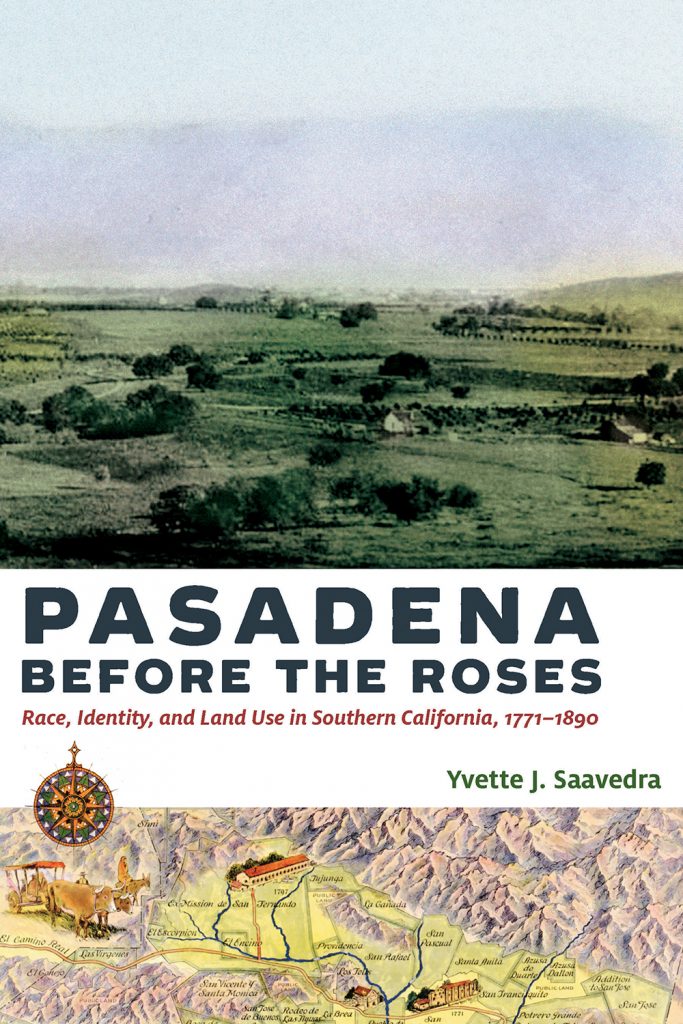Pasadena Before the Roses
Race, Identity, and Land Use in Southern California, 1771–1890
Paperback ($32.00), Ebook ($32.00)
Buy
Incorporated in 1886 by midwestern settlers known as the Indiana Colony, the City of Pasadena has grown into a world-famous tourist destination recognized for the beauty of its Tournament of Roses Parade, the excitement of the annual Rose Bowl, and the charm of the Old Town District.
But what existed before the roses? Before it was Pasadena, this land was Hahamog’na, the ancestral lands of the Tongva people. Later, it comprised the heart of the San Gabriel Mission lands, and in the Mexican period, it became Rancho San Pascual. The 1771 Spanish conquest of this land set in motion several colonial processes that would continue into the twentieth century and beyond.
In Pasadena Before the Roses, historian Yvette J. Saavedra examines a period of 120 years to illustrate the interconnectedness of power, ideas of land use, and the negotiation of identity within multiple colonial moments. By centering the San Gabriel Mission lands as the region’s economic, social, and cultural foundation, she shows how Indigenous, Spanish, Mexican, and American groups each have redefined the meanings of land use to build their homes and their lives. These visions have resulted in competing colonialisms that framed the racial, ethnic, gender, and class hierarchies of their respective societies.
But what existed before the roses? Before it was Pasadena, this land was Hahamog’na, the ancestral lands of the Tongva people. Later, it comprised the heart of the San Gabriel Mission lands, and in the Mexican period, it became Rancho San Pascual. The 1771 Spanish conquest of this land set in motion several colonial processes that would continue into the twentieth century and beyond.
In Pasadena Before the Roses, historian Yvette J. Saavedra examines a period of 120 years to illustrate the interconnectedness of power, ideas of land use, and the negotiation of identity within multiple colonial moments. By centering the San Gabriel Mission lands as the region’s economic, social, and cultural foundation, she shows how Indigenous, Spanish, Mexican, and American groups each have redefined the meanings of land use to build their homes and their lives. These visions have resulted in competing colonialisms that framed the racial, ethnic, gender, and class hierarchies of their respective societies.
"Pasadena before the Roses is a timely and needed contribution to Chicano/a Studies, and historical geography as a wider discipline. Scholars of various regions and time periods can benefit from the intersectional framework of this research ..."–Ethan Battone, Historical Geography
“Pasadena Before the Roses is an important contribution to our understanding of the connections between ideas about optimal land use, racial categorizations, and individual identity in the history of southern California” –Andrew Patrick, The Journal of Arizona History
“Yvette J. Saavedra shows how issues of race and class and gender made and remade local society in Southern California, and how power and politics shaped this region across the long nineteenth century.”—Stephen Pitti, Department of History, Yale University
“Pasadena Before the Roses complicates how we understand the early Los Angeles area. Using an intersectional lens, Saavedra has tapped into a wealth of primary sources to conduct this research and, in doing so, has joined the ranks of some of the best Chicana historians.”—Marne L. Campbell, African American Studies, Loyola Marymount University
“Pasadena Before the Roses is an important contribution to our understanding of the connections between ideas about optimal land use, racial categorizations, and individual identity in the history of southern California” –Andrew Patrick, The Journal of Arizona History
“Yvette J. Saavedra shows how issues of race and class and gender made and remade local society in Southern California, and how power and politics shaped this region across the long nineteenth century.”—Stephen Pitti, Department of History, Yale University
“Pasadena Before the Roses complicates how we understand the early Los Angeles area. Using an intersectional lens, Saavedra has tapped into a wealth of primary sources to conduct this research and, in doing so, has joined the ranks of some of the best Chicana historians.”—Marne L. Campbell, African American Studies, Loyola Marymount University
 The University of Arizona Press
The University of Arizona Press

